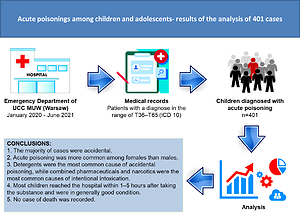Current issue
Archive
Manuscripts accepted
About the Journal
Editorial office
Editorial board
Section Editors
Abstracting and indexing
Subscription
Contact
Ethical standards and procedures
Most read articles
Instructions for authors
Article Processing Charge (APC)
Regulations of paying article processing charge (APC)
PEDIATRICS / RESEARCH PAPER
Acute poisonings among children and adolescents- results of the analysis of 401 cases
1
Student Research Association of Pediatric Emergency Medicine, Medical University of Warsaw, Poland
2
St. Anna’s Hospital of Trauma Surgery in Warsaw, Poland
3
Central Clinical Hospital of the Ministry of the Interior and Administration, Poland
4
Department of Emergency Medical Services, Faculty of Health Sciences, Medical University of Warsaw, Poland
Submission date: 2022-10-28
Final revision date: 2023-01-13
Acceptance date: 2023-01-28
Online publication date: 2023-02-04
Corresponding author
Jan Stachurski
Department of Emergency Medical Services, Faculty of Health Sciences, Medical University of Warsaw, Litewska Street 14/16, 00-575, Warsaw, Poland
Department of Emergency Medical Services, Faculty of Health Sciences, Medical University of Warsaw, Litewska Street 14/16, 00-575, Warsaw, Poland
KEYWORDS
childrensuicide attemptemergency departmentemergency medicinepediatricspoisoningtoxicologyadolescentsintoxicationpoisons
TOPICS
ABSTRACT
Introduction:
Acute poisoning is a significant concern in modern pediatrics and emergency medicine, as it is the fifth leading cause of life-threatening injuries in children under 5 years of age. The aim of this study was to analyze and evaluate the overall patterns of acute poisoning among pediatric patients admitted to the Emergency Department of the Pediatric Hospital of the Medical University of Warsaw.
Material and methods:
The study is a retrospective analysis of the medical records of children aged 0–18 years admitted to the emergency department due to acute poisoning from January 2020 to June 2021 (18 months).
Results:
A total of 401 children aged from 1 month to 18 years old were included in the study. It was the patient’s first poisoning in the vast majority of cases. Most cases were accidental. Acute poisoning was more common among females than males. The most common route of exposure to the poisonous substance was the oral route. The overwhelming majority of patients did not require any antidote treatment. Most children reached the hospital within 1–5 hours after taking the substance and were in generally good condition. Detergents were the most common cause of accidental poisoning, while combined pharmaceuticals and narcotics were the most common causes of intentional intoxication. No deaths were recorded.
Conclusions:
Pediatricians and emergency department staff should be familiar with the management of acute poisoning and be aware of the changing patterns of intoxication depending on age and gender.
Acute poisoning is a significant concern in modern pediatrics and emergency medicine, as it is the fifth leading cause of life-threatening injuries in children under 5 years of age. The aim of this study was to analyze and evaluate the overall patterns of acute poisoning among pediatric patients admitted to the Emergency Department of the Pediatric Hospital of the Medical University of Warsaw.
Material and methods:
The study is a retrospective analysis of the medical records of children aged 0–18 years admitted to the emergency department due to acute poisoning from January 2020 to June 2021 (18 months).
Results:
A total of 401 children aged from 1 month to 18 years old were included in the study. It was the patient’s first poisoning in the vast majority of cases. Most cases were accidental. Acute poisoning was more common among females than males. The most common route of exposure to the poisonous substance was the oral route. The overwhelming majority of patients did not require any antidote treatment. Most children reached the hospital within 1–5 hours after taking the substance and were in generally good condition. Detergents were the most common cause of accidental poisoning, while combined pharmaceuticals and narcotics were the most common causes of intentional intoxication. No deaths were recorded.
Conclusions:
Pediatricians and emergency department staff should be familiar with the management of acute poisoning and be aware of the changing patterns of intoxication depending on age and gender.
Share
RELATED ARTICLE
We process personal data collected when visiting the website. The function of obtaining information about users and their behavior is carried out by voluntarily entered information in forms and saving cookies in end devices. Data, including cookies, are used to provide services, improve the user experience and to analyze the traffic in accordance with the Privacy policy. Data are also collected and processed by Google Analytics tool (more).
You can change cookies settings in your browser. Restricted use of cookies in the browser configuration may affect some functionalities of the website.
You can change cookies settings in your browser. Restricted use of cookies in the browser configuration may affect some functionalities of the website.



